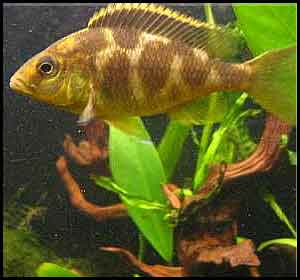
| Species | Venustus Hap |
|---|---|
| Other names | Giraffe Hap |
| Latin Name | Nimbochromis Venustus |
| Family | cichlidae |
| Origin | Africa |
| Length | 20 - 25 cm |
| Temperature | 24 - 28°C |
| Water Hardness | medium hard - hard |
| pH | 7.5 - 8.5 |
| Aquarium Size | 200 L |
| Food | live, frozen, dry, plant |
This freshwater species lives in open areas near rocks in Niasa Lake (Malawi Lakes) with sandy substrate. These fish lives at depths of around 15m.
Colour of the body is yellow-bluish. There are big, irregular spots on the sides of the fish. These spots create something like giraffe pattern. Male is larger and more uniformly colored than female. His head is blue especially during the spawning season. His fin tips are blue with poorly visible dots. The dorsal fin has white border. Colour of the fish is variable and it depends on age of the fish (colours of the young fish are similar to female’s colors) and in case of male - the level in the hierarchy.
This is predatory species – it hunts for small cichlid species and their fry. It can partially bury in the substrate. It doesn’t move and it looks like the surrounding area. It attacks when the victim is within its mouth. The fish often do this in the aquarium – their lie down on their side and they play dead. You should keep these fish with similar size species. Males are aggressive and territorial towards each other, especially during the spawning season. You should keep single male and few females or group of the males in very large aquarium. This is hard and easy to maintain species. It digs in substrate, eats soft leaves of plants. You should not overfeed these fish.
This species prefers a spacious tank which is longer than higher. Aquarium should have soft and fine substrate, a lot of hiding-places among rocks, caves, stones and effective filtration system. A partial water exchange should be done regularly (about 10-20% per week). The iris of this fish is cloudy when water quality in the aquarium is poor.
This is an oviparous species. The fish breed close to the rocks and substrate. Male lures female to his territory after intense courtships. Female lays eggs and she immediately collects them in her mouth. She swims to male’s anal fin. Then male fertilizes the eggs – she swallows his sow-thistle. Female retreats to secure place and she incubates the roe. Incubation lasts about 3 weeks and female doesn’t eat during this time. Offspring in amount of around 100 leaves females mouth. You must start to feed them. Female still protects the offspring for a few days.